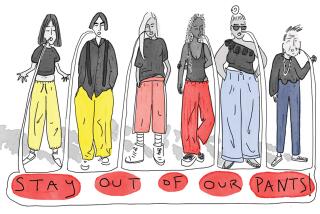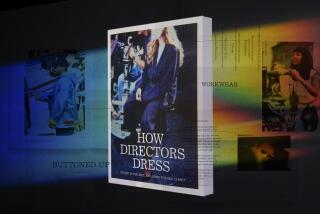Style File : It’s Safe to Go Back in the Water
- Share via
Summer officially begins in 74 days, and it will soon be time to heed the call to get beach-bound and pool-side. For those who have dutifully exercised since fruitcake and eggnog season, the thought of strapping on a swimsuit will not cause undue anxiety. Those who have only recently learned that Twinkies are not complex carbohydrates also can don a stylish swimsuit this summer without fear of startling the lifeguards.
The fashion industry has devoted years to swimsuit design, and now the market features bathing costumes for every figure. Matching body type to the right suit is a snap if you follow a few simple tips.
Suiting Your Needs In the never-ending quest to look like Christie Brinkley frolicking on a tropical island, women have strived to find the perfect swim outfit, one that will accentuate the positive and minimize the negative. Whether it’s enhancing a small bust with ruffles, drapes or shirred necklines or camouflaging large hips with a skirt, there are suits to match any figure. Tank suit or maillot (pronounced my-o): One-piece suit with shoulder straps, usually designed with medium- to high-cut leg. Advantage: High-cut leg openings give short legs appearance of being longer, slimmer. Tank suit with boy-leg: Long, linear maillot silhouette with low-cut leg openings. Advantage: Provides chic silhouette; wider elastic legging maximizes thigh coverage. Blouson: One- or two-piece suit with normal or boy-leg. Soft blousy top, fuller lines. Advantage: Long torso appears shorter; hides thick waist, covers stomach. Tunic or swim dress: One-piece suit with all-around skirt. Advantage: Disguises large hips and thighs. Attached panty provides extra tummy control; detached panty works well for long torsos. Bikini: Two-piece suit; some bikini bottoms are cut higher for more stomach coverage. Advantage: Designed for maximum exposure. Bandeau (pronounced ban-doe): Strapless version of the tank suit, designed for serious sunning. Advantage: Side stays provide bust support. Short torsos look longer; to diminish a full bust, choose solid colors. Sheath: One-piece, sometimes designed with a sarong effect. Advantage: Maximum front coverage. Double front over-panel provides inner thigh coverage, holds in stomach, smooths hips. Wrap or surplice (pronounced sur-plus): Classic V-neck suit designed with a crossover front. Advantage: Flatters full busts. Covers midriff roll, thick waist. Sarong: Loose, side-draped front overskirt. Advantage: Provides inner thigh coverage, flattens stomach. Types of Bras Constructed cup: Molded to support a full bust line. Soft support: Fiber filling for firm but gentle styling. Shelf bra: Unconstructed with a hint of support. Then and Now From the toga-like garments worn in public bathhouses in 350 B.C. Greece to the thonged bikinis worn by countless Sports Illustrated swimsuit models in recent years, swimwear through the ages has made a slow progress toward the public undressing of America. A look at this century’s swimwear: 1910: Hat, heavy wool chemise, bloomers with padded hips, stockings, shoes. 1920: Hat, tight fitting suit, shorts, bathing socks. 1930: Lower neckline, sleeveless, form-fitting, one-piece belted unisex-style suit. 1940: One-piece made of shiny glamour fabrics with a peek-a-boo cut to expose midriff. 1945: Two-piece with a skirt. 1950: The “constructed suit” had boned sides to produce a smooth, long torso and a wired bra lined with a layer of foam rubber to shape the bust into a high pointed bosom. Men kept pace by wearing “Cabana sets”--matching boxer trunks and roomy shirts in vibrant colors and prints. 1955: Strapless two-piece featured exotic patterns and higher cut legs. Could “Beach Blanket Bingo” be too far behind? 1960: Exposed side hips, turtle neck, futuristic metallic design; and for one riotous summer in 1964, topless one-piece suits were the rage. 1965: The one-piece “scandal suit” had see-through netting on neck and sides. 1970: The string bikini exposed the navel and provided scanty coverage of the derriere. 1975: The one-piece had high-cut legs to expose the hips. 1980: The “post-modern” two-piece sported a bandanna top and skirted bottom. 1990: One-piece suits highlighting bust with halter or retro bra, down-the-front openings that are wired, laced or hooked. Also in vogue, skirted suits recalling ‘40s glamour. Sources: International Swimwear and Activewear Market, “Making Waves,” by Lena Lencek and Gideon Bosker






